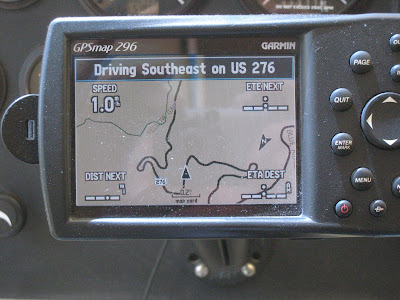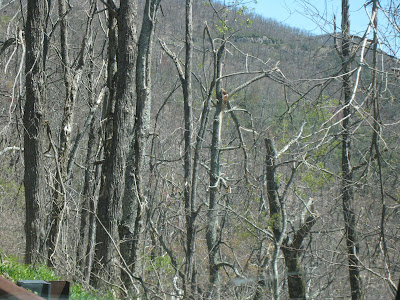
Today's drive took us through rural Georgia, South Carolina, and into North Carolina. Throughout this trip we have tried to avoid Interstate Highways and stick to roads designated on state maps as scenic routes. We've had some unpleasant surprises, but generally have be rewarded with outstanding scenery and views of how people live in this county.
The mountains begin to rise as you leave South Carolina and head nothwest into North Carolina. These are the foothills of the Appalachian Mountains. They are older than the Rockies and feel more rounded, but the rock below is solid granite. Streams create spectacular waterfalls and wonderful sounds of rushing water.
Our destination was the Biltmore House (Estate) in Asheville, NC. We had reserved tickets ahead of time to tour the mansion, but we arrived early enough in the afternoon of the day before that we could tour some aspects of estate using the entry tickets for the following day. We started with the "Kitchen Gardens". Many of the vegetables served in the restaurants on the estate are grown on site.
The scale of the estate itself is beyond grasp. George Vanderbult picked the site, purchased 185,000 acres of land including an entire village which he later tore down and rebuilt and created his dream estate. It was completed in 1895. The mansion has 250 rooms, with more than 174,000 square feet of floor space. It took 6 years and 1000 men to build it. It has 65 fireplaces, 43 bathrooms, 34 bedrooms, and 3 kitchens along with a two lane bowling alley and an indoor swimming pool. Remember, this was all before the turn of the century. When it was first occupied it took a staff of 450 to keep the estate running and the owners and guests properly cared for. Today, it takes a staff of over 2000 to manage the estate and care for the tourists like us who come to enjoy it.
The land around was purchased to preserve the tranquility and the view. Later, all but 8000 acres were sold to the U.S. government and turned into a national forest.
Also on the estate are greenhouses and gardens.
No photography is allowed inside the mansion, so unfortunately we can't share any views from the inside.
When leaving the estate, the exit road takes you right past the mansion. The access roads are just barely wide enough for the motor home so we were able to drive on site and park in one of the many parking lots.
The exit road then takes you through the azalea gardens which were in full bloom. After a day and a half of walking, viewing, wine tasting, and dining we were ready to move on to another adventure.

 The first thing you need to know about the Blue Ridge Parkway is that it isn't designed for speed. This is referred to as America's favorite drive. It's a mostly shoulderless , two-lane road that meanders through leafy hollows and along mountain ridges following the crest of the southern Appalachians. We got on it at Asheville, North Carolina, and drove 80 miles of it to the Great Smoky Park. There were a couple of detours caused by black ice. It had rained and snowed at elevation the night before and there were some sections of the road on the north slopes that didn't thaw out. At one point we had to wait 2 hours before they opened the gate to let us continue.
The first thing you need to know about the Blue Ridge Parkway is that it isn't designed for speed. This is referred to as America's favorite drive. It's a mostly shoulderless , two-lane road that meanders through leafy hollows and along mountain ridges following the crest of the southern Appalachians. We got on it at Asheville, North Carolina, and drove 80 miles of it to the Great Smoky Park. There were a couple of detours caused by black ice. It had rained and snowed at elevation the night before and there were some sections of the road on the north slopes that didn't thaw out. At one point we had to wait 2 hours before they opened the gate to let us continue.






















































